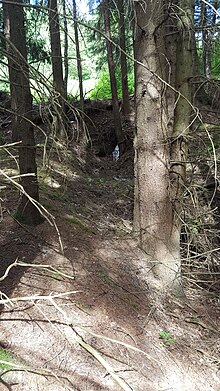Aurora pit (Haiger)
| Aurora | |||
|---|---|---|---|
| General information about the mine | |||
| Dump of the Aurora mine near Niederroßbach | |||
| Mining technology | Civil engineering , open pit mining | ||
| Rare minerals | Quartz , pebbles , lead luster , lead glaze , copper luster , copper pebbles , bornite | ||
| Information about the mining company | |||
| Start of operation | 1757 | ||
| End of operation | 1903 | ||
| Funded raw materials | |||
| Degradation of | Lead , copper , silver | ||
| Geographical location | |||
| Coordinates | 50 ° 47 '48.2 " N , 8 ° 13' 10.3" E | ||
|
|||
| Location | Niederroßbach | ||
| local community | Haiger | ||
| country | State of Hesse | ||
| Country | Germany | ||
| District | Dillenburg mountain area | ||

The Aurora mine (also called Goldkaute ) was a mine near Niederroßbach ( Haiger municipality ) in the Lahn-Dill district . Lead, copper and silver were mined . Initially, ore was probably extracted in open-cast mining, which can still be seen today as pinging evidence. In his work, Becher dedicates a short report to this mine, Mineralogical Description of the Oranien-Nassauische Lande: in addition to a history of Siegen's iron and steel industry . He occasionally mentions the old people , miners in earlier times who were already mining here. David 's pit , which is probably identical to the Aurora pit , was also located near Niederroßbach around 1558 . The elderly are at that time a tunnel of 30 in search of silver Lachter depth have driven into a ravine and come across three passage means. In 1757 a more than 490 Lachter long (deep) tunnel was built on the Rommel, which, however, could only be driven slowly due to the strength of the rock. Probably for this reason a new middle tunnel was dug in 1780, whereby six previously unknown corridor means were discovered, but also that the ancients had already dug deeper. In one of these veins, 200 quintals of pale and lead ore were mined in a short time , where of those held 8 loth of silver per hundredweight . The upper tunnel had a length of 60 holes, the middle one of 110 holes. The pit was still in production for a few years after the deep tunnel reached the main passage, which had 5 corridors, each approx. 10–15 pools in length and 3 feet in thickness . A 9 Lachter deep blind shaft was driven from the deep tunnel, but probably never reached any rock layers that could be mined.

Ernst Frohwein reports on the Aurora that in 1771 it required 1 Florin add-ons on the Kux in one quarter and refers to the Orange-Nassau calendar of 1772. He also writes that four, mostly heavily jagged veins were mined there. The following is an excerpt from his report: ... has built on the following 4 corridors: the main corridor in St. 6 4/8, falling at 58 degrees south, up to 0.9 m thick, which leads to galena and copper gravel with pale ore and zinc blende , the 37 m in Trieschtrumm, lying far in the hanging wall, in St. 6 2/8, touching down with 70 degrees southward falling, in places up to 1.3 m thick and leading to galena with pale ore, there 17 m far in the lying of the main corridor, in St. 6 1/8 trending gravel falling 58 degrees south, 0.3 m thick and little galena and pale ore, but with more copper and sulfur pebbles, and the 3 m further lying down in St. 6 2 / 8 with a 50 degree southerly dip, weak and little lead and white ore leading fourth gear. These tunnels all carry quartz, Letten, and fragments of greywacke, set in clay slate and greywacke, and in part also in alaimed slate, that is, in the coblenz strata, and are mostly very rugged. The main corridor has a length of 350 m and a depth of up to 77 m with 6 worthy means of approximately 100 m total length which, with a thickness increasing up to 0.9 m, leading to lead and pale ores, were mined to the deep tunnel floor. The Trieschtrumm had in the 170 m long and 60 m deep outcrop a 40 m long building worthy means, which was also mined over the deep tunnel. The gravel was mined in 2 ore resources with a total length of 16 to 20 m up to the middle tunnel, while the fourth tunnel has not yet been sufficiently developed. Excellently beautiful steps with large pale ore crystals were found in the Aurora pit.
The street name Aurorastraße in Niederroßbach, like the old dumps, reminds of the former mine. At the beginning of the 1960s, attempts were made to create a sports field on the former mine site. The project was abandoned due to the cost of moving the dump material. The larger flat area in front of the dump area is evidence of this.
See also
literature
- Ernst Frohwein: Description of the Dillenburg mountain area , Bonn 1885
Individual evidence
- ↑ Fr. Wenckenbach: Overview of the simple minerals found in Nassau (from the yearbooks of the Nassau Association for Natural History) . Stuttgart 1880, p. 216 .
- ^ A b c d e Johann Philipp Becher: Mineralogical description of the Oranien-Nassauische Lande: together with a history of Siegen's iron and steel industry . 1789.
- ^ Ernst Frohwein: Description of the Dillenburg mountain area . Bonn 1885.
- ↑ a b F. Odernheimer: The mining and metallurgical industry in the Duchy of Nassau: statist. News, geognost., Mineralog. u. techn. Descriptions d. Deposits of usable minerals, d. Mining u. Ironworks . tape 1 . CW Kreidels, Wiesbaden 1867.

